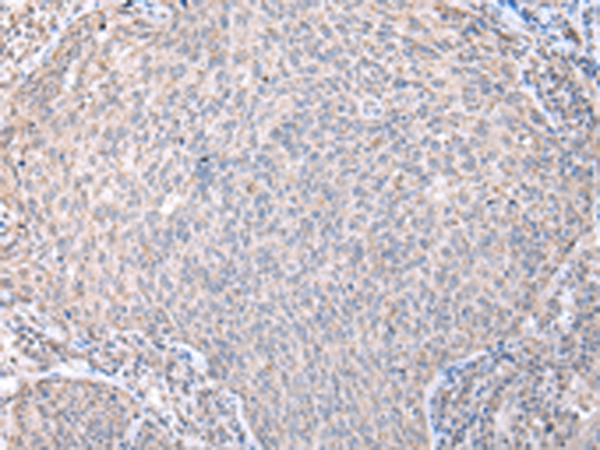
| WB | 咨询技术 | Human,Mouse,Rat |
| IF | 咨询技术 | Human,Mouse,Rat |
| IHC | 1/25-1/100 | Human,Mouse,Rat |
| ICC | 技术咨询 | Human,Mouse,Rat |
| FCM | 咨询技术 | Human,Mouse,Rat |
| Elisa | 1/2000-1/5000 | Human,Mouse,Rat |
| Aliases | Dlc2; DNCL1B; RSPH22 |
| Host/Isotype | Rabbit IgG |
| Antibody Type | Primary antibody |
| Storage | Store at 4°C short term. Aliquot and store at -20°C long term. Avoid freeze/thaw cycles. |
| Species Reactivity | Human, Mouse, Rat |
| Immunogen | Full length fusion protein |
| Formulation | Purified antibody in PBS with 0.05% sodium azide and 50% glycerol. |
+ +
以下是关于DYNLL2抗体的3篇参考文献,按研究方向和内容概括整理:
---
1. **文献名称**: *DYNLL2 binds to MRE11 to limit DNA end resection in BRCA1-deficient cells*
**作者**: Li, S., et al.
**摘要**: 本研究揭示DYNLL2通过结合MRE11核酸酶抑制DNA末端切除,影响BRCA1缺失细胞的同源重组修复。作者利用DYNLL2抗体进行免疫共沉淀(Co-IP)和染色质免疫沉淀(ChIP),证实其与DNA损伤修复复合物的相互作用。
2. **文献名称**: *Characterization of dynein light chain 2 (DYNLL2) in prostate cancer progression*
**作者**: Wang, Y., et al.
**摘要**: 文章通过免疫组化(IHC)和Western blot分析,发现DYNLL2在前列腺癌组织中表达上调,并与肿瘤转移相关。研究使用特异性DYNLL2抗体验证其作为潜在生物标志物的价值。
3. **文献名称**: *Structural insights into the interaction of dynein light chain DYNLL2 with pro-apoptotic proteins*
**作者**: Kumar, R., et al.
**摘要**: 该研究通过X射线晶体学解析DYNLL2与促凋亡蛋白Bim的复合物结构,并利用DYNLL2抗体进行体外Pull-down实验,阐明其在凋亡信号中的调控机制。
---
**备注**:若需获取全文,可通过PubMed或期刊官网输入DOI/标题查询。部分研究可能涉及抗体品牌(如CST、Abcam)的使用说明,建议进一步查阅抗体供应商的技术文档。
DYNLL2 (dynein light chain 2), also known as LC8-type 2. is a small but evolutionarily conserved protein belonging to the dynein motor complex family. It plays a critical role in intracellular transport, organelle positioning, and mitotic processes by linking dynein to cargo molecules and regulatory proteins. DYNLL2 shares homology with DYNLL1 (LC8-type 1) and participates in diverse cellular functions, including signal transduction, apoptosis, and cell cycle regulation. It interacts with multiple binding partners, such as the pro-apoptotic protein Bim and tumor suppressor p53. modulating their stability and activity.
Antibodies targeting DYNLL2 are essential tools for studying its expression, localization, and molecular interactions. These antibodies are widely used in techniques like Western blotting, immunohistochemistry (IHC), and immunofluorescence (IF) to investigate DYNLL2's role in physiological and pathological contexts. Research has implicated DYNLL2 dysregulation in cancer progression, particularly in breast and ovarian cancers, where altered expression correlates with metastasis and chemoresistance. Additionally, studies suggest its involvement in neurological disorders, such as Huntington’s disease, through disrupted axonal transport mechanisms.
Commercial DYNLL2 antibodies are typically raised against specific epitopes, with validation data confirming specificity and cross-reactivity (e.g., distinguishing DYNLL2 from DYNLL1). However, challenges remain in standardizing antibody performance across experimental models. Ongoing research aims to clarify DYNLL2's precise mechanisms and therapeutic potential, driving demand for reliable antibody reagents in both basic and translational studies.
×